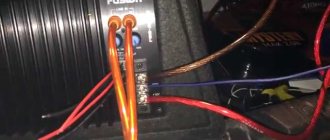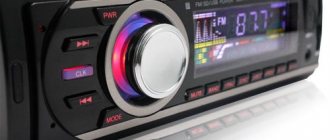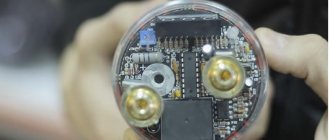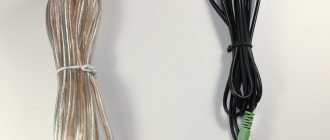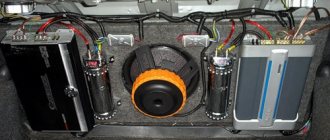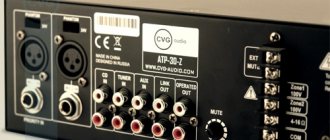Not only the sound quality, but also the reliability of the entire sound system depends on the choice of wires and connection of the speakers in the car. It is important to know which wire to use for the speakers. Any car audio system consists of several components. Depending on the level of difficulty, their number may vary. There must be a signal source, power amplifier and speakers. There may be several of them. These are front speakers, side speakers on car doors, rear speakers on the trunk lid and a subwoofer.
The opinion that it is enough to purchase high-quality sound equipment and your car will have great sound is wrong. Many people do not attach much importance to connecting cables for audio equipment, although they are ultimately responsible for the quality of sound reproduction.
Which wires are best to use for car speakers?
Most car enthusiasts do not know what wires are needed for speakers, although the principle of choice is quite simple. All cables that are used in a car to connect audio equipment are divided into three groups:
- Power
- Interblock
- Acoustic
Power cables are designed to supply power from the car battery to the amplifier, since the music center is already connected by standard cabling. In order to determine the cross-section of the power wire, it is enough to calculate the total power of the sound system and divide this value by the voltage of the vehicle's on-board network in accordance with the formula I=P/U. The result is the current consumed.
For an amplifier with 4 channels of 40 watts each, this value will be equal to 24 amperes. 40*4*2=24. You need to multiply by two, since 40 watts is the rated power. Next, you need to take into account the distance from the battery to the amplifier. With a cable length of 3-4 meters, its cross-section should be at least 8.0 mm2. Interconnect cables come in two types. This is a twisted pair wire or coaxial cable with a central core and metal braid. The best results will be obtained using double-shielded copper coaxial cable. Very important elements of the sound system are the wires running from the amplifier to the speakers.
Types of cables
Today the market is full of “interconnect” wires of different colors, and the price will also satisfy everyone:
- Here everything depends not so much on the quality, but on the manufacturer’s brand (fame and reputation)
- We don’t need Super elite wires in gold-plated packages with velvet lining, so we’ll focus on affordable models
Interblock connectors are divided into two large categories:
- The first category, focused on the transmission of analog signals (“interconnectors” or “analog” wires)
- The second category is intended for transmitting exclusively digital data; for simplicity, they are called “digital” cables
"Analog" wires
Example of wires for analog signals
This type of interconnects is designed to transmit low-current signals coming from a source to devices for processing it, an amplifier, a switch, and others:
- To ensure such a connection, a shielded audio wire is usually used, which is arranged according to the coaxial arrangement of its conductors - the central conductor will be protected from extraneous interference by a screen, which is usually made of a large number of thin metal veins
- This design allows you to avoid interference from electrical appliances located nearby and allows you to conduct a low-current signal with minimal losses
- When connecting such wires, convenient RCA connectors are used (popularly called “tulips” or “bells”)
- They are the most common in household appliances today.
- As a rule, the term “interconnect cable” means a connector that consists of two wires and 4 RCA connectors (in simpler terms, a “2-tulip to 2-tulip” wire), which is capable of transmitting signals from two channels of one component of your system to another
"Digital" wires
Digital type is divided into two types:
- Wires designed to transmit a digital signal in the form of electric current (colloquially they are called “digital coaxials”)
- The second type transmits a digital signal in the form of light (these are “optical” cables, also known as fiber optics)
Let's start in order:
- This wire is no different in appearance from the “analog” interconnect
- The difference is that it does not have a second connector
- “Digital coaxial” consists of only one wire at the ends with connectors (the connectors are usually RCA)
- Simply put, the cable turns out to be “1 tulip - 1 tulip”
- It is manufactured using a coaxial circuit (hence the name), but unlike the “analog” one, the “digital coaxial” must have a characteristic impedance of 75 Ohm
- It is desirable that its connectors have a characteristic impedance of 75 Ohm, however, this is not a necessary condition; it is usually fulfilled only in the manufacture of expensive “household” and all professional wires
Let's move on to fiber optic cables:
- The digital signal is transmitted through flexible optical fiber in the form of light.
- The fiber is made from a special polymer (used in inexpensive wires of the average price and quality category)
- Made from specially designed flexible glass (such cables are more expensive)
Optical wires have several advantages over electrical "coaxials":
- "Optics" is capable of transmitting a large amount of digital information
- Plus, optical fiber allows for ground isolation between the two components (which is important for connecting the computer system unit to the receiver)
- However, high-quality optical wire is very expensive, and its cheap implementation and data transmission scheme in budget equipment do not allow you to enjoy the benefits of “optics”
- Therefore, you should not overpay for a “digital” wire; it is better to pay attention to “digital coaxial”
- If we compare middle-class digital and coaxial components, there will be no fundamental difference in sound
- Most likely you will not hear the difference between “coaxial” and “optics”
- Of course, connect anything, it’s worth remembering that “coaxial” is always cheaper than similar “optics”
Maximum cable length
Some wires have a maximum length:
- Optical cable length - maximum 7 meters
- “Electrical coaxial” has no restrictions, since everything depends on the quality of the wire itself
- If you use a good quality wire, digital data can be transmitted without problems over 10-15 meters or even more
Which one to choose for your equipment
Everything is very simple here:
- Go to any audio equipment store, borrow several of the most suitable interconnects as collateral and compare their sound with the use of your system
- Exactly in your room and with your system
- Then you will have an accurate idea of the “sound quality” of each wire
Wires for car speakers
Wires for car audio speakers are selected according to several parameters. This is the conductor material, insulation type and cross-section. Speaker cables are made from several types of materials:
- Silver
- Copper
- Aluminum
In terms of the quality of transmission of an alternating audio frequency signal, a connecting cable made of pure silver is the undisputed leader. It has minimal resistance, does not oxidize and does not introduce significant distortion. It is rarely used in cars due to its high price. Cables made of copper coated with a thin layer of silver give good sound, with a slight increase in high frequencies. Pure oxygen-free copper is the main material for connecting cables to speaker systems. These wires are used most often. Wires for connecting aluminum speakers have higher resistance, which affects the quality of signal transmission. In addition, aluminum oxidizes faster and is more brittle, which can make it difficult to install inside the car. Copper-coated aluminum cables are somewhat better in quality, but in any case worse than copper wires.
Digital cable yourself
Perhaps, if we are talking about a coaxial “digital” wire, since making an optical cable at home takes a lot of effort and money - it is much easier to purchase a ready-made one:
- And a “digital coaxial” with your own hands is quite possible, especially if the entire system is made of mid-level components
- Make a pure “digital” cable if you don’t want to overpay a lot of money, knowing that there won’t be much benefit from the purchased one
- So, the requirements that we place on “digital coaxial”
- Firstly, the design, and secondly, the required characteristic impedance of 75 Ohm
- A regular antenna wire meets these requirements.
- Didn't you think it's a high-quality antenna cable? You can also buy a high-quality video cable (for example, Canare) in professional equipment stores; the quality of such wire is guaranteed to be better than that sold on the radio market; according to the seller, it's very good
Important: if you don’t have expensive components, if you plan to make a cable 1-2 meters long, then you can completely forget about the effect of a digital cable on the sound, since any homemade “digital coaxial” assembled from an antenna or video cable with two high-quality connectors will not work worse than store-bought “digital coaxial”
Note: Forget about lead-containing solders when making interconnect wires, or forget about sound quality.
- Well, you won’t have a beautiful box, a fashionable nameplate on the wire and connectors (this will not affect the sound in any way)
- But homemade is cheaper and it will look good
Wires for car audio speakers
The wire for car speakers is a flexible multi-core cable with copper cores and polymer insulation. Polyvinyl chloride (PVC) or polypropylene foam is most often used as an insulating coating. The highest quality connecting cable is a product with Teflon insulation. The most important thing when choosing a cable for speakers is to correctly determine its cross-section. It is believed that the most common cable for car speakers with a cross-section of 2.5 mm2 ensures normal operation of a four-channel amplifier with front and rear speakers. To reproduce sound with satisfactory quality, this cross-section is suitable, but in order to obtain high-quality sound, the cross-section should be at least doubled. This is noticeable even by ear, especially when connecting speakers that are 3-4 meters away from the amplifier.
The whole truth about wires (to be honest, not quite the whole truth, but a lot). Magazine "Avtozvuk"
The author of the article is ready to share his experience based on hundreds of comparative auditions and independent design of connecting wires.
Save and read later -
Having regularly visited several audiophile Internet forums where there is active discussion of various components, I have noticed one clear pattern: everyone who actively claims that connecting wires cannot sound different if they are made of the same material never bases their results own experiments. Because they were not carried out. Their argument is “this can’t happen because it can never happen.” And the topic of wire direction is like a red rag to a bull for them. They can’t just pass by like that, they will definitely support with their “+1” those who mock the “confused audiophiles.” But all the defenders of the other camp invariably present the results of their comparative auditions. I consider myself to be in the second camp and am ready to share my experience based on hundreds of comparative auditions and independent design of connecting wires. Namely design, because despite their apparent simplicity, wires are a complex structure, and the following design elements are valid for both speaker cables and interconnects. This is true even for power cables, perhaps with a slight adjustment to the specific application.
Section
One day, while I was installing audio systems in cars, our local electrician, who had worked as a communications operator in Soviet times, came into my installation center. When I saw the 2Ga power cable that we ran into the trunk of the car to connect the amplifier, I was really stunned. His words: “We used this cable to connect radio stations broadcasting halfway around the world.” Since then, I have a saying: you cannot approach such a delicate topic as sound reproduction with Ohm’s law. It would be more accurate to say this: it’s impossible only with Ohm’s law...
I should note that recently, even those starting their journey in car audio understand the need for high-quality power supply for amplifiers. This happened due to the fact that all car audio forums give recommendations on the cross-section of power wires, and stores have kits for connecting amplifiers with wires, although not very thick, but still sufficient. But no one wants to use thick speaker wires. Moreover, if beginners buy what is offered to them in stores, then sound lovers “in the know” simply assume that the wires have a cross-section of 2.5 square meters. mm are quite sufficient for any frontal acoustics, because the power of the speakers is much less than the iron, which is also connected with a 2.5 kW wire. mm. And indeed, if you operate with the only quantity accessible and understandable to the common consumer—power—then you can’t argue with that. However, I undertake to argue and even expect to win this argument (otherwise I would not undertake it). And in my evidence base I will use electrical parameters that are understandable and familiar to a hypothetical electrician who approaches sound reproduction using Ohm’s law. No esotericism, no attacks, like “if you don’t hear this, it means you’re deaf...”
So. The electrodynamic head is essentially an alternating current electric motor that converts an electrical signal into mechanical movements of the diffuser with excitation of sound waves. The more accurately the diffuser repeats the electrical signal of the audio frequency, the more accurately the sound we hear will correspond to its standard, that is, the live sound that was recorded. This is all theoretical and if we do not take into account the distortion of the electronic path. For our current topic, the starting point will be the precision of mechanical vibrations. In fact, the moving part of the dynamic head has some kind of mass, which means it has inertia when oscillating. And in order to accurately control movements, the amplifier must have a damping coefficient (DC) sufficient for this. The term “damping factor” is also often used. A value that not all manufacturers provide in the technical data of their products. It is not difficult to calculate the value of the coefficient; you need to divide the load resistance by the output impedance of the amplifier and get the desired figure. We just need to do this now. I have never seen output resistance in the declared characteristics of amplifiers, and it is not a constant at all, resistance varies with frequency, that is, it is impedance. But for our purposes this is not fundamental, because even if we allow an error of 100%, the conclusions we will come to below will not change. Let's take the average value of the output resistance of a transistor amplifier - 0.02 Ohms, and the load resistance is 4 Ohms. We get a damping coefficient of 200. A very good value, although it can be higher.
Now we can move directly to proving the need to use thick speaker wires. We obtained the required coefficient without taking into account the resistance of the connecting wires, but it is such that taking it into account in this simple formula gives completely different results. After browsing through the websites of cable manufacturers, I found the resistance value of a copper speaker cable with a cross-section of 2.5 square meters. mm - 0.0075 Ohm/m. But this is the resistance of one conductor, and the circuit uses two, so let’s multiply by 2. Typically, amplifiers are located in the trunk of a car, and the average cable length to the front speakers is 4 m. We calculate the resistance of an acoustic cable of this length: 0.0075 x 2 x 4 = 0.06 Ohm, that is, 3 times the output impedance of the amplifier! Taking this into account, the actual damping coefficient becomes equal not to 200, but... we consider: 0.02 + 0.06 = 0.08, 4/0.08 = 50. This is already a small coefficient, and taking into account the fact that modern car speakers have heavy progress, it becomes clear that there can be no talk of any legible reproduction. The speaker cone will "fly past" the stopping point due to inertia, since the amplifier will not be able to control the vibrations due to the high resistance between it and the speaker. Let's try to increase the cross-section of the acoustic wire to 10 square meters. mm and thereby reduce the resistance by 4 times. We get completely different numbers: 0.06/4 = 0.015, and the new value of CD is 114, which is 2.3 times better than in the first case. Now it is clear that the thicker the speaker cable and the shorter it is, the better the sound. This applies not only to the low-frequency range, where a large amplitude of vibrations occurs, but also to mid-range frequencies, which significantly improve intelligibility. Thick wires are quite problematic to install through car doors, but such difficulty is rewarded with high-quality sound. Based on the calculations made, the subwoofer simply needs to be connected with thick wires, and this is much easier to do than running a wire through the door.
From my own experience I will say: the difference in sound between an acoustic wire of 4 sq. mm and the same double - 8 sq. mm is perfectly audible, all you need to do is everyone who wants to make sure of this, take and conduct this simple experiment. In my home system, I connected the speakers with a homemade speaker cable with a cross-section of 40 square meters. mm and have never regretted it.
Conductor material
The most common material for audio wires is copper, it is known. But the quality of copper can be completely different, and we are not able to determine it; this requires expensive instruments and equipment. I only urge you not to believe in the characteristics declared by manufacturers; they often do not correspond to reality, precisely because of the impossibility of verification. You have to take it and listen for yourself. The conductor made of pure silver performed very well - the sound is noble, rich in overtones and aftertones. However, the price of such a cable starts from hundreds of dollars per meter, and this fact greatly limits its use even in expensive systems. A conductor made of silver-plated copper is often found; practice has shown that such a conductor greatly distorts the timbre, the sound is colored, even harsh. This is explained by the fact that the current squeezed out by the skin effect at high frequencies enters a layer of conductor with different characteristics, and some distortion occurs. On sound, this is heard as an “increase in brightness” at mid-high frequencies (for example, brass, cymbals) and a decrease in “air” and the size of the sound stage, “room acoustics” are eaten up. You also come across a conductor made of tinned copper; the sound of such a wire is characterized by a pronounced lisp effect, the sound is downright dirty. At the same time, there are often cases when tinned copper is passed off as a silver-plated conductor.
Insulation material
There are a huge variety of dielectrics that are used as insulating material for audio cables; this is generally a separate topic that can take dozens of pages in length. I will try to briefly describe the frequently used ones. The most common dielectric material for insulating conductors is polyvinyl chloride (PVC) and its variations. This is the same transparent, translucent or completely opaque material that is found on acoustic and power wires sold today for the car audio industry. This dielectric has a charge accumulation effect, so it has a strong and negative effect on the audio signal. Imagine that the main sound signal passed through the conductor, and after it, lagging in time (phase distortion) and with a much smaller, but still significant amplitude, the accumulated signal transmitted by the insulation runs. The sound becomes muddy and inexpressive. Moreover, this effect depends on the length of the cable and increases with increasing length. Over several meters the sound will be much worse than over a short section of cable. In addition, PVC oxidizes copper, especially at the edges of the wire, where there is air access. Polypropylene insulation is not used as often as PVC; it is much better for sound, especially foam. This is the least expensive of the "acoustically correct" isolators. Teflon insulation is already used on expensive audio cables; insulation made from low-density Teflon and foamed Teflon has shown particularly good results. Some manufacturers have even patented several technologies for making insulators from this material.
It was experimentally established that the most sound-neutral insulators are natural materials: cotton, linen, wool, cellulose; they are practically impossible to find in mass-produced products, and only sometimes they are used in expensive and custom-made audio connectors of the highest class. In general, any insulator affects the sound signal, even the second layer, which does not come into contact with the conductor. The speaker wires in the car should be laid as far as possible from the metal of the body; corrugated pipes allow you to “move” the cable both from the body and from the carpets.
Cable design
It would seem that it makes no difference how the conductors are located in the cable, because they are insulated and do not come into contact with each other. In fact, from two completely identical conductors you can make cables that sound completely different. Conductors are twisted at different angles, laid in parallel, spaced at different distances, several conductors are parallelized, flat cross-section conductors are used, a conductor is assembled from conductors of different diameters, and much more. I will not specifically describe each option - there are a huge number of them, which means that there is no single correct design. Conductors spaced further apart make it possible to obtain values of linear capacitance and inductance almost equal to zero - the detail of the sound increases noticeably, but cohesion and musicality are lost. The main task of wire designers, besides, of course, neutrality and broadband, is to obtain the optimal combination of detail/musicality. It is against these three criteria that audio connectors should be evaluated.
Two basic cable designs with very different characteristics
| Parallel arrangement of conductors | Four conductors in a common screen | Twisted pair in foil shield with stock wiring |
Felix SKAKUN, audio expert
Prepared based on materials from the Avtozvuk magazine, September 2009
www.avtozvuk.com
This article was read 101,205 times
The article is included in the sections:
How to choose. Buyer's GuideUseful Tips"Do It Yourself"
Wire for speakers in column
An important part of getting high-quality sound is connecting cables to the amplifier and speakers. The speaker wire in your car can be connected in several ways. Typically, a wire clamp under a washer and nut is used, or ready-made cables with RCA or “tulip” connectors are used. Often the stripped wire is pressed into a flat petal-type contact. When clamping a stripped wire, it must be thoroughly tinned so that the copper at the junction does not oxidize. The use of ready-made cables is complicated by the fact that they are produced at a certain length and it can be difficult to route the cables as needed for the configuration of the sound system.
